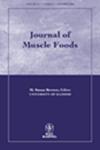The impact of using natural fermentation with lactic acid bacteria (LAB), chemical acidification with liquid lactic acid, and encapsulated citric, gluconic or lactic acid were evaluated in raw and cooked salami-type products. Liquid lactic acid resulted in an immediate pH drop and significant increase in L*(lightness) and a*(redness) values, as well as clumping of the ground meat particles that exhibited moisture release due to excessive protein denaturation. Overnight LAB fermentation also resulted in increased L*and a*values, but unlike direct acid addition, did not cause moisture loss or clumping. Spectra data, collected after both treatments reached pH 4.6, revealed pretty similar curve shape, with higher values for the fermented product at 420–550 nm and 610–670 nm. The encapsulated acids, designed to release acid at about 62C, did not affect the color of the raw meat batters. Cooking of all treatments resulted in higher L*and a*values, both by about 50%. L*and a*values were pretty similar for all the acidified and non-acidified control. The only exception was a no-nitrite control, which showed a significantly (P < 0.05) lower a*value.
The use of different acidification methods to lower the pH of meat products (bacteria fermentation, direct acid addition, encapsulated acid) does affect the color of the product. When going through the process, care should be given to the rate of acidification. A slow acid production (fermentation) or acid release when the meat proteins have started to go through heat coagulation (by using acid encapsulated in hydrogenated vegetable oil) are recommended. Direct acid addition results in immediate lightening of the product as well as crumbling of the ground meat particles, which later negatively affect color and texture of the product.


